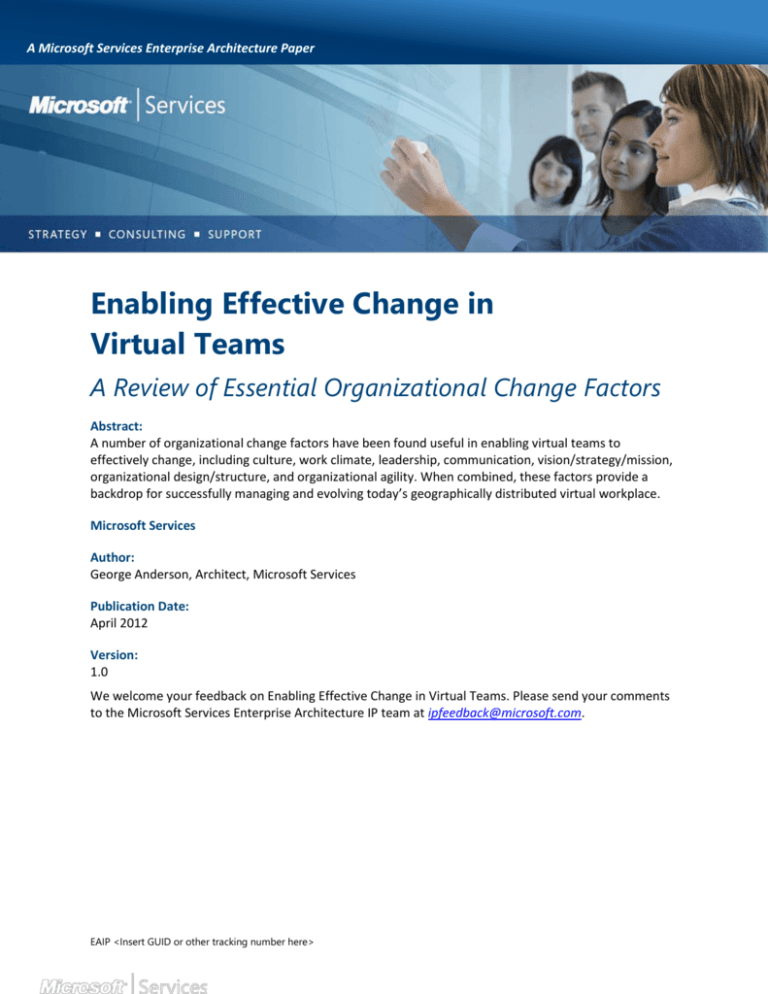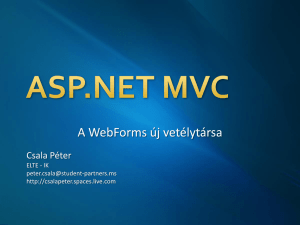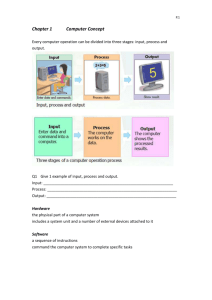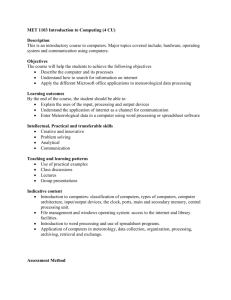
A Microsoft Services Enterprise Architecture Paper
Enabling Effective Change in
Virtual Teams
A Review of Essential Organizational Change Factors
Abstract:
A number of organizational change factors have been found useful in enabling virtual teams to
effectively change, including culture, work climate, leadership, communication, vision/strategy/mission,
organizational design/structure, and organizational agility. When combined, these factors provide a
backdrop for successfully managing and evolving today’s geographically distributed virtual workplace.
Microsoft Services
Author:
George Anderson, Architect, Microsoft Services
Publication Date:
April 2012
Version:
1.0
We welcome your feedback on Enabling Effective Change in Virtual Teams. Please send your comments
to the Microsoft Services Enterprise Architecture IP team at ipfeedback@microsoft.com.
EAIP <Insert GUID or other tracking number here>
Enabling Effective Change in Virtual Teams
A Review of Essential Organizational Change Factors
Acknowledgments
The author wants to thank the following people who contributed to, reviewed, and helped improve this
white paper.
Contributors:
Paul Slater
Thanks also to:
Jon Tobey
© 2012 Microsoft Corporation. All rights reserved. This document is provided "as-is." Information and views expressed in this
document, including URL and other Internet website references, may change without notice. You bear the risk of using it.
This document does not provide you with any legal rights to any intellectual property in any Microsoft product. You may copy and
use this document for your internal reference purposes. This document is confidential and proprietary to Microsoft. It is disclosed
and can be used only pursuant to a non-disclosure agreement.
© 2012 Microsoft Corporation
Page ii
Enabling Effective Change in Virtual Teams
A Review of Essential Organizational Change Factors
Table of Contents
1
EXECUTIVE SUMMARY .................................................................................................................................... 1
2
ESSENTIAL ORGANIZATIONAL CHANGE FACTORS FOR VIRTUAL TEAMS .......................................................... 2
2.1
2.2
2.3
2.4
2.5
2.6
2.7
2.8
CULTURE ............................................................................................................................................................2
WORK CLIMATE AND MORALE ................................................................................................................................3
LEADERSHIP IMPLICATIONS .....................................................................................................................................4
PREFERRED VIRTUAL TEAM LEADERSHIP STYLES..........................................................................................................4
MANAGING COMMUNICATION ...............................................................................................................................5
VISION, STRATEGY, AND MISSION............................................................................................................................6
ORGANIZATIONAL DESIGN AND STRUCTURE...............................................................................................................7
SETTING THE STAGE FOR ORGANIZATIONAL AGILITY ....................................................................................................7
3
CONCLUSION .................................................................................................................................................. 9
4
REFERENCES .................................................................................................................................................. 10
© 2012 Microsoft Corporation
Page iii
Enabling Effective Change in Virtual Teams
A Review of Essential Organizational Change Factors
1 Executive Summary
The purpose of this paper is to explore a number of organizational change factors that have been shown
to be useful in enabling virtual teams to effectively change. The factors include culture, work
climate/morale, leadership, communication, vision/strategy/mission, organizational design/structure,
and the collective impact these factors have on a final factor—organizational agility. When combined,
these factors provide a backdrop for effectively managing and successfully evolving today’s
geographically distributed and likely culturally diverse virtual workplace.
© 2012 Microsoft Corporation
Page 1
Enabling Effective Change in Virtual Teams
A Review of Essential Organizational Change Factors
2 Essential Organizational Change Factors for Virtual Teams
Well-known leadership guru Tom Peters once remarked “It is easier to kill an organization than it is to
change it.”1 No modern-day organization is as fraught with change as those that are dispersed across
time zones, geographies, and cultures. For this reason, the theme of geographically distributed or
“virtual” project-oriented team challenges has become one of the foremost issues faced by
organizations today.
Remotely dispersed teams place a special burden on organizational change. This burden is especially
apparent when local executive leadership is absent and the functional teams that comprise the
organization do not lend themselves to a clear-cut organizational authority or division of labor. In such
scenarios, organizational design, or “the process of defining and coordinating organizational structure
elements”2 can drive the structure and development of such teams and its team members in many
directions. Certainly no one approach is always ideal, but without a yardstick to measure organizational
change effectiveness, developing a geographically distributed team is challenging at best.
Transformational leadership tenets can provide a yardstick, to be sure, but experience has uncovered a
host of factors or attributes that are germane to organizations and those leaders who have shown
themselves adept at successfully introducing change.
First, it has been shown that attention to the external environment is paramount.3 Whether an
organization adopts a whole-systems approach to change or a model colored in some other manner by
open systems theory, working within the confines and constraints of a particular environment with the
knowledge that the environment is only a microcosm of a larger environment is a constant. In the end,
only when the larger environment is taken into consideration—along with inputs, outputs, and a timely
and appropriately vectored feedback mechanism—can the other core change model components or
themes be leveraged. Outside of attention to the external environment, a review of successfully
changed organizations suggests that effective change is also predicated on the following essential
organizational change factors:
Sensitivity to organizational culture
The ability to transform climate or morale for work teams or workgroups
Transformation-enabling leadership styles and behaviors
Effective and productive communication
Attention to vision, strategy, and mission
Organizational design and structure
The ability to enable and give impetus to organizational agility
Each of these factors is examined in the following sections in context of what it means to effect change
in a geographically distributed virtual team organization.
2.1 Culture
More so than any other factor, true organizational change is affected by culture, which can welcome
change or push it aside in favor of maintaining the status quo. For example, in a study of hundreds of
chief information officers (CIOs) who are responsible for deploying transformational Enterprise Resource
1
Peters, T. (1997). The circle of innovation. New York: Random House.
Dunham, R. B. (2004). Organizational structure and design. Retrieved November 22, 2009 from
http://instruction.bus.wisc.edu/rdunham/MHR420/2004%20PPT/structure_web.ppt.
3
Burke, W. W., & Litwin, G. H. (1992). “A causal model of organizational performance and change.” Journal of
Management, 18(3), 532-545.
2
© 2012 Microsoft Corporation
Page 2
Enabling Effective Change in Virtual Teams
A Review of Essential Organizational Change Factors
and Planning (ERP) solutions around the globe, culture was identified as the number one factor.4
Effectively cultivating and managing culture to accept change is therefore critical to enabling
organizational change.
Culture is one of several factors (in addition to strategy, organizational structure, and several others)
with the capacity to modify the very patterns of existence or deep structure that defines the
organization. Without culture change, authentic organizational change is difficult to accomplish if not
impossible.5 Steering an organization’s culture can revolutionize or transform the organization, unlike
the continuous improvement changes most organizations naturally plan for and seek as they evolve and
grow over time. Cultural pressures affect organizational performance and explain why individuals and
teams alike will seek out and pursue lofty goals, even at great personal expense and sacrifice.6
Thus, creating a culture that is equipped for and receptive to change is necessary. Fortunately, as borne
out in practice and academia, cultures can indeed be cultivated that are naturally more inclined or prone
to accept change.7 However, in today’s world of geographically distributed multicultural organizations,
developing a culture that is amenable to change is hard work. After all, you can’t “change culture by
changing culture.” Instead, you need to influence other organizational factors that in turn affect culture.
The need to purposefully influence work climate, another essential organizational change factor, is
examined next.
2.2 Work Climate and Morale
Effective leaders understand that creating a great place to work requires attention to more than
organizational culture. Why? Because the “local” atmosphere found within a work team is eminently
more critical to individual employee satisfaction and team productivity than the culture of the
organization as a whole. A good organization might lure top talent in the door, but unless the work team
to which the newcomer is assigned understands the importance of work climate and management seeks
to preserve a healthy work climate, retention will suffer. Ultimately, the organization’s development will
also suffer as its productivity flounders amid morale and esteem-related issues and related problems.
In particular, work team morale is central to work climate; the quality of work life is reflected in
employee well-being or morale, enabled by empowerment, and embodied by job satisfaction. It is one
of several factors that comprise group dynamics ultimately worker happiness and productivity.8
Interestingly, the overall work team atmosphere amounts to how individuals view both their future and
their past in the context of the organization. The fact that the morale of a group is stronger when the
group plays a role in crafting its own environment or circumstances is a clear indicator of work climate’s
power to transform organizations, although admittedly not as much as the deep structure changes
made possible by changing culture.
Many organizational change experts view work climate as a transactional rather than transformational
lever in the development of an organization and how it adapts and transforms in the face of change. Yet
as the central factor in the Burke-Litwin model, it is equally clear that all roads—all organizational
4
Nah, F. F., Zuckweiler, K. M., & Lau, J. L. (2003). “ERP implementation: Chief information officers' perceptions of
critical success factors.” International Journal of Human-Computer Interaction, 16(1), 5-22.
5
Burke, W. W. (2002). Organization change: Theory and practice. London: Sage Publications.
6
Gold, M. (1999). The complete social scientist: A Kurt Lewin reader. Washington, D. C.: American Psychological
Association.
7
Schein, E. H. (1985). Organizational culture & leadership: A dynamic view. San Francisco: Jossey-Bass.
8
Gold, M. (1999) Ibid.
© 2012 Microsoft Corporation
Page 3
Enabling Effective Change in Virtual Teams
A Review of Essential Organizational Change Factors
change factors—lead to work climate. It may not transform the organization in and of itself, but the
quality of an organization’s work climate directly affects the receptiveness and effectiveness of that
organization’s ability to change.
2.3 Leadership Implications
The increase of geographically distributed teams has placed a burden on core organizational change and
leadership theory today, especially in cases where the team is similar to an island or string of islands
around the globe—far from local mid-level and executive leadership, isolated in a sense, but critical to
organizational success nonetheless. A mix of leadership styles (transformational, transactional,
contingent, and others) acts as the leadership basis for most of these cases.
However, teams must be fine-tuned at a minimum, or sometimes reinvented altogether, to be initially
fruitful and certainly to remain effective long-term. The underlying reasons are many. First, a wellperforming geographically dispersed team implies a team that, by its nature, must be comprised of
mature self-directed and highly motivated personnel. With the absence of “local management,” only the
most competent and self-sufficient individuals will be successful long-term; a successful geographically
dispersed team alludes to the need for consummate professionals of high self-esteem and self-efficacy.
In the absence of such professionals, a particular leadership style may be necessary to maximize team
effectiveness (along with the need for much more active “management” on the part of leaders).
Second, a geographically dispersed team inherently implies time-zone and cultural differences (whether
across town or across countries), both of which demand leadership that is characterized by excellent
communication and relationship skills. Boies9 found that “members of face-to-face groups reported
feeling more interpersonal attraction towards other team members than did members of electronic
groups” or virtual teams, thereby affecting individual contributions to achieving the team’s goals.
Introducing face-to-face meetings in a virtual team environment is clearly valuable when possible; when
not possible, supplanting these with virtualized face-to-face meetings is preferred over voice-only or
asynchronous methods such as email and voicemail.
Finally, remote teams require more feedback, acknowledgement, and typically more attention to
creating a sense of connection or belonging than their centralized team counterparts. The virtually
managed team requires a leader adept in building cohesiveness and monitoring work climate; physical
proximity to leadership does not minimize an individual’s innate need to belong and be connected.
Connectedness and communication ward off employee retention issues10, after all, essentially an
unavoidable organizational life-cycle phenomenon that generally must be minimized to maintain a
highly productive and happier team.
2.4 Preferred Virtual Team Leadership Styles
To be effective in an environment that is subject to ongoing change, especially the kind of change that
necessitates improvisational attention, certain leadership styles should be embraced and others
avoided. An autocratic method is counterproductive; virtual team leaders even more so than their
centralized counterparts need to feel that they are a part of the decision-making process, that they have
a say in the team’s organization and circumstances. A contingent reward leadership style might do well
in managing the simplest of administrative or organizational tasks, but will do little for building a
9
Boies, K. (2002). A theoretical framework exploring the role of affect in virtual leadership. Retrieved January 11,
2007, from http://luxor.acadiau.ca/library/ASAC/v23/230509.pdf.
10
Bordia, P., Hunt, E., Paulsen, N., Tourish, D., & DiFonzo, N. (2004). Uncertainty during organizational change: Is it
all about control? European Journal of Work and Organizational Psychology, 13(3), 345-365.
© 2012 Microsoft Corporation
Page 4
Enabling Effective Change in Virtual Teams
A Review of Essential Organizational Change Factors
cohesive team. A servant-led leadership style would also prove less effective in such location-challenged
circumstances, in that much of the team-building communication between team members and
leadership might be unnecessary in the wake of the leader’s “taking care of business” approach to
leadership. And charismatic leaders, although inspiring and interesting to work for, would find
themselves at odds with the reality of completing the more-than-typical time-consuming tasks of team
administration, retention, and task coordination.
Case studies and academics disagree which leadership style is most effective for leading virtual teams. In
some cases, the most effective leader of virtual teams seems to be the relationship-oriented leader.11
And because relationships must necessarily be maintained across time and space, not only is an
outstanding communicator required, but also one that is willing to learn and entertain new
communications mediums (from instant messaging to chat rooms, video-conferencing, net-meetings,
and more – anything to band the team together and build intra-team relationships). Indeed, the most
effective transformational leaders must embrace more than change—they must seek out and inject
innovation into their organizations to be the most effective leaders and managers of their teams.
In other cases, the best type of leadership for a dispersed team that is faced with impending change is
one that balances transactional and transformational approaches. The transactional side of the leader
could presumably ensure that administrative matters are addressed, that tasks are optimized relative to
workflow and overall efficiency, and that matters outside of the individual team members’ control are
seen to. The leader’s transformational side could embrace each team member’s ideas and suggestions
for improvement, facilitate the exchange of these ideas among team members, and then effect change
as the team deems appropriate.
Other research has shown that a particular type of leader fares best in maximizing both organizational
performance as well as work-climate morale. Labeled an “achievement-oriented” leader, this person
typically maintains a strong task focus while setting forth challenging “stretch” goals for the
organization.12 More effective than his power-oriented or relationship-oriented counterparts, the
findings associated with this achievement leader set the stage for Burke-Litwin’s focus on work climate
as the model’s centerpiece. However, without sound communication, such leadership will still fall short,
as explored in the following section.
Experience shows that combining transformational leadership with attention to organizational design
and other important details serves to develop and promote a set of common beliefs or values, thereby
fostering a consistent and more effective corporate culture and stronger work climate. In this way, the
organization can be motivated to achieve a greater level of group performance than is individually
attainable, which sets the stage for transformation that enables both deep structure change and
improved work team productivity without sacrificing morale, longevity, and esprit de corps.
2.5 Managing Communication
Sound, timely communication is essential not only to leadership and effective management practices,
but to the organization and its mechanisms for change. Communication affects culture and it influences
work climate.13 Communication is the primary driver behind converting strategic vision into strategy,
mission, and finally change. It gives substance to change; great leaders possess the ability to effectively
11
Joyce, K. E. (2004). “Whole-System, collaborative change in schools: Engaging affiliated nonprofit entities in
jointly planning their future.” OD Practitioner, 36(2), 1-8.
12
Burke, W. W. (2002). Organization change: Theory and practice. London: Sage Publications.
13
Nah, F. F., Zuckweiler, K. M., & Lau, J. L. (2003). “ERP implementation: Chief information officers' perceptions of
critical success factors.” International Journal of Human-Computer Interaction, 16(1), 5-22.
© 2012 Microsoft Corporation
Page 5
Enabling Effective Change in Virtual Teams
A Review of Essential Organizational Change Factors
communicate their vision both inside and outside their organizations. Through effective communication,
“leaders breathe life” into their visions, thereby enabling change through contagious enthusiasm and a
can-do spirit.14
Given their distributed structure, virtual teams present unique communications challenges. Workers
need to be shielded from unnecessary and therefore distracting disturbances while still maintaining
open lines of communication.
Communication plays a role in propping up employee morale, too. Of course, the effect on morale still
largely depends on “whether the information being communicated is good or bad news.”15 That
technology can more rapidly and accurately communicate problems and opportunities, or improve
decision making, matters little to employees who are unable to take advantage of such technology.
What of the future modern-day workplace, though? Given the overarching need of all systems to
maintain their own integrity and continuity,16 improved communications within the realm of virtual
organizations was precisely what Gibb17 called for when he described his TORI trust model (Trust,
Openness, Realization and Interdependence). According to Gibb, high integrity promotes improved
communication, and sound communication in turn promotes greater trust. Levitt and colleagues18
describe the methods and values of communication and coordination that are necessary for distributed
teams in light of global virtual work processes that “include measures of activity flexibility, complexity,
uncertainty, and interdependence strength.” Organizations founded in anything other than sound
communication, underpinned by trust and optimized for virtual teams, run the risk of limited longevity
for themselves and their constituents. This risk is especially evident for inherently complex multicultural
teams.
2.6 Vision, Strategy, and Mission
A number of traditionally strategic factors combine to enable widespread change. These factors are
vision, strategy, and mission. Mitchell’s19 view on this is pragmatic: “Strategy-making ensures that
organizations are responsive to their changing external environments and to their stakeholders and
clients.” Burke20 shares important dimensions of effective change models, primary of which is
transformational strategy or strategic vision. Effective change models thus necessarily incorporate an
understanding of the current state, a desired or future state, and the steps or phases deemed
appropriate to navigate between the two. Burns21 (1978) describes these steps or phases as “when a
person imagines a state of affairs not presently existing…[ultimately] elaborated into a broader vision of
14
Kouzes, J. M., & Posner, B. Z. (2002). The leadership challenge (3rd ed.). San Francisco, CA: Jossey-Bass.
Bordia, P., Hunt, E., Paulsen, N., Tourish, D., & DiFonzo, N. (2004). Uncertainty during organizational change: Is it
all about control? European Journal of Work and Organizational Psychology, 13(3), 345-365.
16
Scott, W. R. (2003). Organizations: Rational, natural, and open systems (5th ed.). Upper Saddle River, NJ:
Prentice Hall.
17
Gibb, J. R. (1978). Trust: A new view of personal and organizational development. Los Angeles: Guild of Tutors
Press.
18
Levitt, R. E., Thomsen, J., Christiansen, T. R., Kunz, J. C., Jin, Y., & Nass, C. (1999). Simulating project work
processes and organizations: Toward a micro-contingency theory of organizational design. Management Science,
45(11).
19
Mitchell, J. (2003). Strategy-making in turbulent times. Retrieved May 2, 2007, from
http://www.voced.edu.au/content/ngv125.
20
Burke, W. W. (2002). Organization change: Theory and practice. London: Sage Publications.
21
Burns, J. M. (1978). Leadership. New York: Harper & Row.
15
© 2012 Microsoft Corporation
Page 6
Enabling Effective Change in Virtual Teams
A Review of Essential Organizational Change Factors
change.” Because vision, strategy, and mission are generally accepted as self-evident principles of
effective organizational change and management, discussion of them in this paper is limited.
2.7 Organizational Design and Structure
The purpose of organizational design is to create a structure or design that serves to effectively
coordinate organizational tasks and motivate people to achieve an organization’s objectives.22 Rottman
and Lacity23 further define this factor as “the capability to design and implement organizational
arrangements to realize plans and contracts.” Organizational structure has also long been viewed in
terms of an adaptive organism shaped in reaction to the characteristics and commitments of
participants as well as to influences from the external environment.24 Such an “institutional” approach
or framework could naturally evolve and change as an organization’s needs or mission changed. To
extend the biological metaphor, organizations would seem to have lives of their own, looking and acting
in many ways like individual persons with individual person-like behaviors.
Although such an approach could be leveraged as a framework for creating an effective organizational
design, a number of structure, leadership, integration, and motivational factors exist that were never
fully addressed in earlier change models based on Selznick’s institutionalism. His approach also made no
mention of how to work through the processes of creating a hierarchy of authority, establishing
communications channels to help coordinate tasks and other activities, and assigning responsibility for
coordinating work between people and teams. Different structures are more or less adept in these
areas; how organizations manage communication is a good example.
Although Selznick valued and built upon Barnard’s25 classic “recognition of the motivating power of
purpose and the ways in which organizational structures and procedures themselves become infused
with value,”26 his model also failed to encompass or value the role that positive reinforcement plays in
both individual and organizational success relative to adopting change. Fortunately, transformational
factors such as attention to the environment, strategy, culture, and leadership enable organizations to
transcend counter-productive structures that inhibit goal achievement. In this way, organizations and
their constituents can track their progress along a continuum of change,27 whether evolutionary or
revolutionary, and make organizational design and structure changes (among other essential
adjustments) along the way as warranted.
2.8 Setting the Stage for Organizational Agility
When combined, the preceding factors act to encourage or stifle organizational agility. In the context of
virtually managed, culturally diverse teams, such agility may well be the most critical and least
understood theme today. Although large size is traditionally associated with agility deficiency, in trying
22
Dunham, R. B. (2004). Organizational structure and design. Retrieved November 22, 2009 from
http://instruction.bus.wisc.edu/rdunham/MHR420/2004%20PPT/structure_web.ppt.
23
Rottman, J. W., & Lacity, M. C. (2004). “Proven practices for IT offshore outsourcing.” Sourcing and Vendor
Relationships Advisory Service, 5(12).
24
Scott, W. R. (2003). Organizations: Rational, natural, and open systems (5th ed.). Upper Saddle River, NJ:
Prentice Hall.
25
Barnard, C. I. (1938). The functions of the executive. Boston: Harvard University Press.
26
Scott, W.R. (2003) Ibid.
27
Lusthaus, C., Adrien, M., & Anderson, G. (2002). Organizational assessment: A framework for improving
performance. Retrieved February 2, 2010, from http://www.idrc.ca/openebooks/998-4/.
© 2012 Microsoft Corporation
Page 7
Enabling Effective Change in Virtual Teams
A Review of Essential Organizational Change Factors
times even small organizations can be crippled by inactivity that is brought on by ineffective leadership
style, inappropriate organizational structure, lack of attention to strategy and vision, and so on.
Agility enables creativity by soliciting solutions from constituents and “approaching old situations in new
ways.”28 The current increase in the use, number, distribution, and size of teams within the context of
larger organizations underscores how important it is to apply a change model that is capable of
addressing interconnected but increasingly autonomous islands of productivity. Agility also has a direct
bearing on how effectively teams can capture and share knowledge while permitting flexible just-in-time
staffing,29 which enables teams to creatively react to changing workloads.
In this way, agility enables both innovation and evolution. By way of example, organizational agility
makes it possible to troubleshoot and resolve issues more quickly—the “right” person is assigned to
tackle problems in their domain rather than the one currently available. Agility then allows process
modification to help ensure future similar problems are routed to the proper teams and other
resources, leveraging captured knowledge and lessons learned to avoid the problem in the first place. In
the end, by supporting long-term problem resolution, agility enables change while conserving scarce
organizational resources.
28
Bass, B. M., Avolio, B. J., Jung, D. I., & Berson, Y. (2003). “Predicting unit performance by assessing
transformational and transactional leadership.” Journal of Applied Psychology, 88(2), 207-218.
29
Rottman, J. W., & Lacity, M. C. (2004). “Proven practices for IT offshore outsourcing.” Sourcing and Vendor
Relationships Advisory Service, 5(12).
© 2012 Microsoft Corporation
Page 8
Enabling Effective Change in Virtual Teams
A Review of Essential Organizational Change Factors
3 Conclusion
Organizational change may be evolutionary and incremental in response to the slowly changing needs of
an organization. Or change may be revolutionary, the result of deep structure change which in turn
affects the very culture and work climate of an organization. Other factors may be equally
transformational, including an organization’s vision, strategy, and mission, leadership style and
behaviors, communication, organizational design and structure, and organizational agility. In view of
today’s geographically distributed teams and their inescapable role as organizational change agents, the
ability to manipulate and maximize these transformational factors or “levers” facilitates not only
organizational agility but longevity as well.
For more information about Consulting and Support solutions from Microsoft, contact your Microsoft
Services representative or visit www.microsoft.com/services.
© 2012 Microsoft Corporation
Page 9
Enabling Effective Change in Virtual Teams
A Review of Essential Organizational Change Factors
4 References
Barnard, C. I. (1938). The functions of the executive. Boston: Harvard University Press.
Bass, B. M., Avolio, B. J., Jung, D. I., & Berson, Y. (2003). “Predicting unit performance by assessing
transformational and transactional leadership.” Journal of Applied Psychology, 88(2), 207-218.
Boies, K. (2002). A theoretical framework exploring the role of affect in virtual leadership. Retrieved
January 11, 2007, from http://luxor.acadiau.ca/library/ASAC/v23/230509.pdf.
Bordia, P., Hunt, E., Paulsen, N., Tourish, D., & DiFonzo, N. (2004). Uncertainty during organizational
change: Is it all about control? European Journal of Work and Organizational Psychology, 13(3), 345365.
Burke, W. W. (2002). Organization change: Theory and practice. London: Sage Publications.
Burke, W. W., & Litwin, G. H. (1992). “A causal model of organizational performance and change.”
Journal of Management, 18(3), 532-545.
Burns, J. M. (1978). Leadership. New York: Harper & Row.
Dunham, R. B. (2004). Organizational structure and design. Retrieved November 22, 2009 from
http://instruction.bus.wisc.edu/rdunham/MHR420/2004%20PPT/structure_web.ppt.
Gibb, J. R. (1978). Trust: A new view of personal and organizational development. Los Angeles: Guild
of Tutors Press.
Gold, M. (1999). The complete social scientist: A Kurt Lewin reader. Washington, D. C.: American
Psychological Association.
Joyce, K. E. (2004). “Whole-System, collaborative change in schools: Engaging affiliated nonprofit
entities in jointly planning their future.” OD Practitioner, 36(2), 1-8.
Kouzes, J. M., & Posner, B. Z. (2002). The leadership challenge (3rd ed.). San Francisco, CA: JosseyBass.
Levitt, R. E., Thomsen, J., Christiansen, T. R., Kunz, J. C., Jin, Y., & Nass, C. (1999). Simulating project
work processes and organizations: Toward a micro-contingency theory of organizational design.
Management Science, 45(11).
Lusthaus, C., Adrien, M., & Anderson, G. (2002). Organizational assessment: A framework for
improving performance. Retrieved February 2, 2010, from http://www.idrc.ca/openebooks/998-4/.
Mitchell, J. (2003). Strategy-making in turbulent times. Retrieved May 2, 2007, from
http://www.voced.edu.au/content/ngv125.
Nah, F. F., Zuckweiler, K. M., & Lau, J. L. (2003). “ERP implementation: Chief information officers'
perceptions of critical success factors.” International Journal of Human-Computer Interaction, 16(1),
5-22.
Peters, T. (1997). The circle of innovation. New York: Random House.
Rottman, J. W., & Lacity, M. C. (2004). “Proven practices for IT offshore outsourcing.” Sourcing and
Vendor Relationships Advisory Service, 5(12).
Schein, E. H. (1985). Organizational culture & leadership: A dynamic view. San Francisco: JosseyBass.
Scott, W. R. (2003). Organizations: Rational, natural, and open systems (5th ed.). Upper Saddle
River, NJ: Prentice Hall.
© 2012 Microsoft Corporation
Page 10







